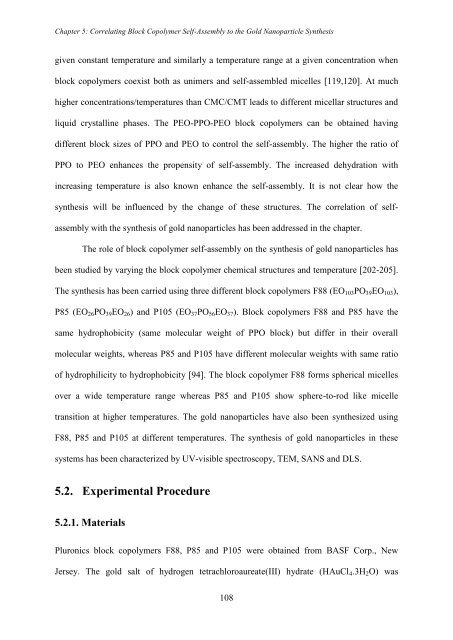PHYS01200704032 Debes Ray - Homi Bhabha National Institute
PHYS01200704032 Debes Ray - Homi Bhabha National Institute
PHYS01200704032 Debes Ray - Homi Bhabha National Institute
You also want an ePaper? Increase the reach of your titles
YUMPU automatically turns print PDFs into web optimized ePapers that Google loves.
Chapter 5: Correlating Block Copolymer Self-Assembly to the Gold Nanoparticle Synthesis<br />
given constant temperature and similarly a temperature range at a given concentration when<br />
block copolymers coexist both as unimers and self-assembled micelles [119,120]. At much<br />
higher concentrations/temperatures than CMC/CMT leads to different micellar structures and<br />
liquid crystalline phases. The PEO-PPO-PEO block copolymers can be obtained having<br />
different block sizes of PPO and PEO to control the self-assembly. The higher the ratio of<br />
PPO to PEO enhances the propensity of self-assembly. The increased dehydration with<br />
increasing temperature is also known enhance the self-assembly. It is not clear how the<br />
synthesis will be influenced by the change of these structures. The correlation of selfassembly<br />
with the synthesis of gold nanoparticles has been addressed in the chapter.<br />
The role of block copolymer self-assembly on the synthesis of gold nanoparticles has<br />
been studied by varying the block copolymer chemical structures and temperature [202-205].<br />
The synthesis has been carried using three different block copolymers F88 (EO 103 PO 39 EO 103 ),<br />
P85 (EO 26 PO 39 EO 26 ) and P105 (EO 37 PO 56 EO 37 ). Block copolymers F88 and P85 have the<br />
same hydrophobicity (same molecular weight of PPO block) but differ in their overall<br />
molecular weights, whereas P85 and P105 have different molecular weights with same ratio<br />
of hydrophilicity to hydrophobicity [94]. The block copolymer F88 forms spherical micelles<br />
over a wide temperature range whereas P85 and P105 show sphere-to-rod like micelle<br />
transition at higher temperatures. The gold nanoparticles have also been synthesized using<br />
F88, P85 and P105 at different temperatures. The synthesis of gold nanoparticles in these<br />
systems has been characterized by UV-visible spectroscopy, TEM, SANS and DLS.<br />
5.2. Experimental Procedure<br />
5.2.1. Materials<br />
Pluronics block copolymers F88, P85 and P105 were obtained from BASF Corp., New<br />
Jersey. The gold salt of hydrogen tetrachloroaureate(III) hydrate (HAuCl 4 .3H 2 O) was<br />
108

















